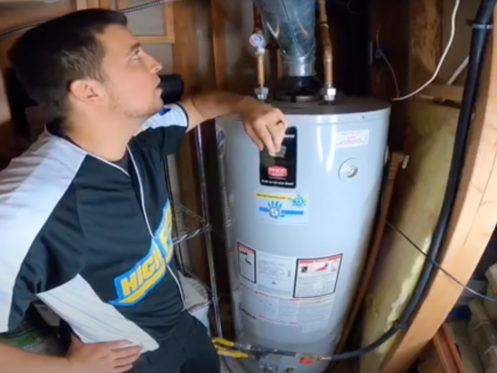Just about everyone has got his or her own perception with regards to What Kind of Maintenance Do Water Heaters Need?.

Warm water is important for daily convenience, whether it's for a refreshing shower or cleaning meals. To guarantee your hot water system runs efficiently and lasts longer, routine upkeep is vital. This post supplies practical pointers and understandings on exactly how to preserve your home's hot water system to stay clear of disturbances and pricey repair services.
Intro
Preserving your home's hot water system could seem daunting, yet with a couple of basic steps, you can ensure it operates efficiently for several years to come. This guide covers every little thing from recognizing your hot water system to DIY upkeep pointers and understanding when to call in professional help.
Relevance of Preserving Your Hot Water System
Regular upkeep not only extends the life-span of your warm water system however also guarantees it operates efficiently. Ignoring maintenance can cause decreased effectiveness, greater energy costs, and even premature failing of the system.
Indications Your Hot Water System Demands Maintenance
Recognizing when your warm water system needs focus can avoid major concerns. Watch out for indications such as inconsistent water temperature level, odd noises from the heating system, or rusty water.
Recognizing Your Hot Water System
Before diving right into maintenance jobs, it's useful to recognize the fundamental parts of your hot water system. Normally, this consists of the water heater itself, pipelines, anode rods, and temperature level controls.
Monthly Upkeep Tasks
Regular month-to-month checks can aid catch small issues prior to they intensify.
Flushing the Hot Water Heater
Flushing your water heater eliminates debris buildup, enhancing performance and extending its life.
Monitoring and Replacing Anode Rods
Anode poles prevent rust inside the container. Examining and changing them when worn out is important.
Evaluating and Readjusting Temperature Settings
Readjusting the temperature setups makes certain optimal performance and security.
DIY Tips for Maintenance
You can do several maintenance jobs on your own to keep your hot water system in leading problem.
Looking for Leaks
On a regular basis inspect pipes and connections for leaks, as these can result in water damages and greater bills.
Evaluating Stress Alleviation Valves
Testing the pressure relief valve guarantees it operates appropriately and stops too much stress buildup.
Insulating Pipes
Insulating hot water pipelines minimizes warmth loss and can save energy.
When to Call a Professional
While DIY maintenance is useful, some concerns call for specialist expertise.
Complicated Problems Needing Professional Help
Instances include major leaks, electrical troubles, or if your hot water heater is constantly underperforming.
Regular Expert Maintenance Benefits
Specialist upkeep can consist of extensive examinations, tune-ups, and making certain conformity with security standards.
Final thought
Routine maintenance of your home's warm water system is necessary for effectiveness, longevity, and price financial savings. By following these tips and recognizing when to look for specialist assistance, you can guarantee a trusted supply of warm water without unexpected disruptions.
How to Maintain an Instant Hot Water Heater
Before tinkering with your hot water heater, make sure that it’s not powered on. You also have to turn off the main circuit breaker and shut off the main gas line to prevent accidents. Also turn off the water valves connected to your unit to prevent water from flowing into and out of the appliance. 2. When you’re done, you have to detach the purge valves’ caps. These look like the letter “T” and are situated on either side of the water valves. Doing so will release any pressure that has accumulated inside the valves while at the same time avoid hot water from shooting out and burning your skin. 3. When the purge valves’ caps are removed, you have to connect your hosing lines to the valves. Your unit should have come with three hoses but if it didn’t, you can purchase these things from any hardware or home repair shops. You can also get them from retail stores that sell water heating systems. Read the user’s manual and follow it to complete this task properly. When the hosing lines are connected, open the purge port’s valves. 4. You should never use harsh chemical cleaners or solutions when cleaning your unit. Make use of white vinegar instead. It should be undiluted and you’ll probably use about 2 gallons. 5. Now flush your water heater. This task should probably take about 40 minutes. We can’t give you specific directions for this because the procedure is carried out depending on the type, model and brand of your heater. With that being said, refer to the user’s manual. 6. When you’re done draining the unit, you have to turn off the purge port valves again. Remove the hosing lines that you earlier installed on each of the water valves. Put the valve caps (purge port) back in their respective places and be very careful so as not to damage the rubber discs that are found inside these caps. 7. Now that everything’s back in place, check your user’s manual again to find out how to reactivate your water heating system. 8. Once it is working, turn one of your hot water faucets on just to let air pass through the heater’s water supply pipes. Leave the tap on until water flows smoothly out of it. https://www.orrplumbing.com/blog/2014/september/how-to-maintain-an-instant-hot-water-heater/

As an enthusiastic reader about How to Maintain Your Water Heater & Prolong its Life, I was thinking sharing that piece of content was important. Are you aware of somebody else who is intrigued by Tips For Maintaining Your Hot Water Heater? Feel free to promote it. Thank-you for going through it.
Call Today